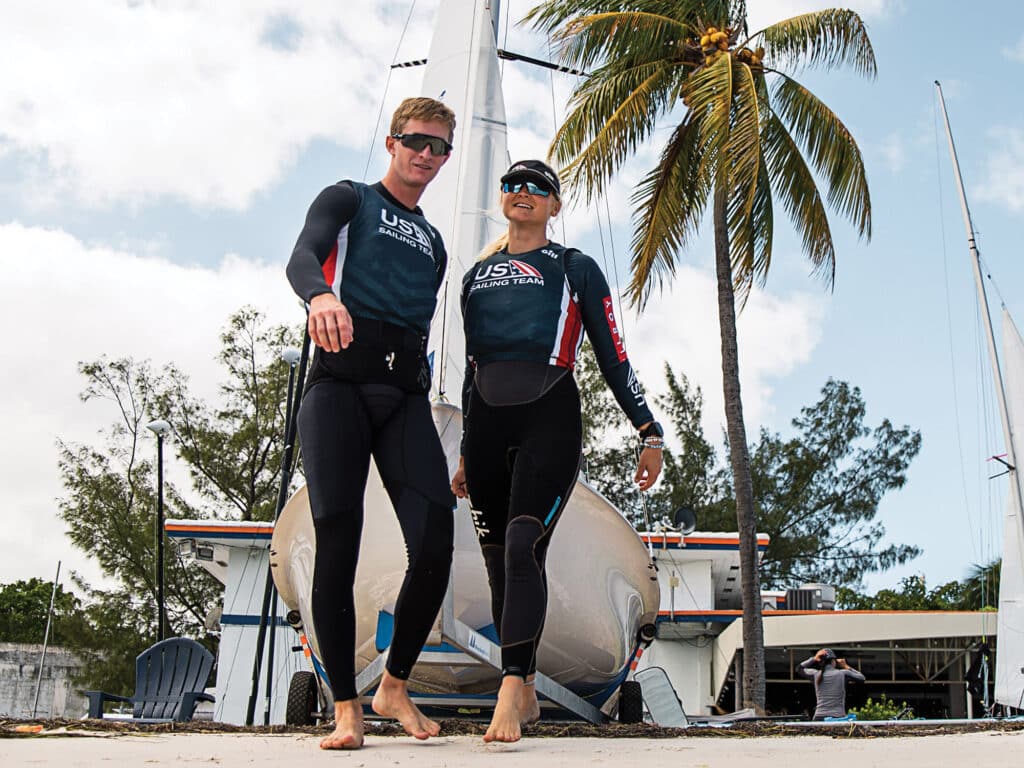
Training alone in their International 470 off the south shore of Long Island, New York, in the summer of 2021, Louisa Nordstrom and Trevor Bornarth were a world away from the spectacle of the Tokyo Games. There, Olympians Stu McNay and Dave Hughes rolled their sails together for the last time, marking the end of the individual men’s and women’s Olympic 470 disciplines and the beginning of the new Mixed Olympic 470 era. For Nordstrom and Bornarth, and many young sailors looking to reach the pinnacle of dinghy sailing, this new coed medal provides a unique opportunity to compete in the Paris and Los Angeles Games.
“It (the switch to a mixed class) does level the playing field a little bit for a new sailor coming into the fleet because everyone has to reset by sailing with a new person,” Nordstrom says. “There’s a lot of younger talent coming into the 470 because I think it’s easier to get into the class given that everyone is starting fresh.”
Nordstrom, 24, from Sarasota, Florida, grew up racing in the ILCA 6, Club 420 and 29er fleets and excelled at Yale, receiving four College Sailing All-American honors before graduating in 2020. Bornarth, two years younger and from Port Solerno, Florida, stood out in the International 420 class, placing second at the 2017 World Sailing Youth World Championships. While pursuing Olympic 470 sailing full time, Bornarth is also enrolled online at the University of Florida.
The pair first connected in Newport in the fall of 2020 through the US Sailing Team Olympic Development Program, an initiative aimed at preparing elite youth sailors for Olympic-level competition. With both sailors aiming for the 2024 Games, they began their campaign with the Oyster Bay 470 Team and were named to the US Sailing Team in 2022.
A year and a half later, now with the full resources of the US Sailing Team, their most significant challenges still lie before them. Following years of intense training and competition, however, Nordstrom and Bornarth are dialing in their performance, and their results are getting them ever closer to the top.
“Last year was a big year of figuring out how to sail the 470 fast—and that is a huge project,” Bornarth says. “Now we’re focused on racing, in-the-boat communication, and how we’re making decisions in tactical situations where you can either gain three boats or lose three boats. That’s how we can go from struggling in the upper-middle pack to punching through to the medal race consistently.”
Developing Olympic-level performance in the 470 is a lifelong mission, says two-time Olympian Dave Hughes. “You never finish learning how to sail a 470,” he says. “It has many modes available to you, both upwind and downwind, and you pay a large price if you spend time in a mode that is not ideal. You can sail the boat at an A level for an entire race and artificially think that you’re at an A-plus level, but you pay the price with your results.”
With Nordstrom and Bornarth each bringing a unique background and experience to the 470, they rely on each other’s strengths to excel in a variety of conditions. “Louisa is an absolute weapon at calling the shifty stuff—college sailing definitely paid off there. When it’s cranking, and Louisa can’t see anything, I’m calling tactics,” Bornarth says.
The ability for teams to rely on both partners in the tactical conversation is paramount for success in the 470, Hughes says: “Most successful teams are running it so that the crew and the helm can appropriately shift the tactical football. You have to be able to transfer authority on the tactics effectively—there’s just so much to be gained and lost in the margins that that’s where the best teams show their prowess, and that’s how you win regattas.”
Training with international partners in Europe has allowed Nordstrom and Bornarth to work with the world’s leading teams while the American 470 fleet continues to develop. “We’ve worked a lot together with the Italians, the Israelis and the Brits,” Nordstrom says. “Being in Europe and being able to go early to events and train together with the entire fleet has been an absolute game-changer.”
The duo also uses state-of-the-art technology to improve during domestic solo training sessions. “We have trackers, and at the end of the day, we can put it all on a tablet and analyze different aspects of our sailing,” Bornarth says. “That makes it a little more productive than it would be if we just say, ‘Oh, we’re going out to look at this new mainsail,’ and we’re by ourselves—we don’t get any data off it. Now that we’re incorporating these sailing instruments, it’s been a lot more productive.”
Seeing success in their racing results after years of hard work is a major driving factor in Nordstrom and Bornarth’s campaign. Finishing 13th at the 2022 International 470 European Championship in Turkey, their best campaign result to date, has motivated them to become even better. “Turkey was really exciting, as we were finally in the front of the fleet,” Nordstrom says. “We’ve known we can do it, and it was great to finally get a taste of accomplishing it. I think a big motivation going forward is to continue experiencing that feeling.”
Nordstrom and Bornarth represent a generation of younger 470 sailors stepping into a notoriously technical and specialized class. Spearheaded by the Olympic Development Program and the private Oyster Bay 470 Team, collegiate sailors and recent graduates flocking to the boat are revitalizing what was recently considered a dying one-design class.
“Right now, the problem is we need boats,” Bornarth says. “People are looking to buy more boats, and a lot of the [420] youth teams are starting to cross over. Domestically, US Sailing has done a great job of starting to promote the 470 again, and if we can get 10 boats on the starting line of the [2023 West Marine] US Open Sailing Series, that will probably be the first time in a decade that we’ve had that.”
The 470 remains one of the world’s most competitive classes despite the influx of new sailors following the change to a mixed format.
“I think, initially, the switch definitely leveled the playing field. But as we’ve seen over the past six months, it has fully ramped up—all the top guys are back with new crews or crews from the women’s or men’s squad,” Bornarth says. “You still have all the same sailors that were initially at the top of the men’s and women’s fleets now at the top of this fleet, so it’s still very challenging. Now that we’ve combined the men’s and women’s fleets, it’s gotten deeper. While the level may not be as high as it was in the top three of the men’s or women’s fleets, now the top 15 are there.”
Strong competition is also returning to the United States, with four-time 470 Olympian Stu McNay partnering with 2021 Women’s 470 Olympian Lara Dallman-Weiss. The full consequences of the shift to the mixed format will not be known for years to come, but current results show promise in assisting the development and longevity of the fleet.
“There’s a lot behind the decision for it going mixed,” says Hughes, who serves on World Sailing’s Athletes’ Commission, a body that represents Olympic athletes in World Sailing’s decision-making process. “Ultimately, it did yield a case for [the 470] being in for another two Olympics: Paris and LA. Does that help the class? Absolutely, it does. Is the class different in terms of the people and the vibe? Yes, for sure. There are some people who have stuck on after Tokyo, but mostly it has provided a lot of newcomers an opportunity in the class. I think it is healthy, and now it is up to the class over the next two years to show that it can become the type of class that is more modern in terms of its racing, thought process and class development, and really deserves to be in the Olympic schedule.”
While Nordstrom and Bornarth have a long road ahead, they’re enjoying every moment of it.
“It’s all about the process and enjoying it,” Bornarth says. “The big thing in our campaign is making sure that even tasks that aren’t that fun, we try to find the joy in it. We tell ourselves every day that we’re living the dream—this is what we want to be doing.”
While the Olympic regatta was a world away not too long ago, the call of Marseille is fast becoming a real thing for Nordstrom and Bornarth. There will be plenty more sails to roll before then, and if Olympic aspirations come up short in 2024, the next big shot in Long Beach is right around the corner in 2028.









